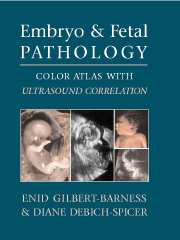Book contents
- Frontmatter
- Contents
- Foreword by John M. Opitz
- Preface
- Acknowledgments
- 1 The Human Embryo and Embryonic Growth Disorganization
- 2 Late Fetal Death, Stillbirth, and Neonatal Death
- 3 Fetal Autopsy
- 4 Ultrasound of Embryo and Fetus: General Principles
- 5 Abnormalities of Placenta
- 6 Chromosomal Abnormalities in the Embryo and Fetus
- 7 Terminology of Errors of Morphogenesis
- 8 Malformation Syndromes
- 9 Dysplasias
- 10 Disruptions and Amnion Rupture Sequence
- 11 Intrauterine Growth Retardation
- 12 Fetal Hydrops and Cystic Hygroma
- 13 Central Nervous System Defects
- 14 Craniofacial Defects
- 15 Skeletal Abnormalities
- 16 Cardiovascular System Defects
- 17 Respiratory System
- 18 Gastrointestinal Tract and Liver
- 19 Genito-Urinary System
- 20 Congenital Tumors
- 21 Fetal and Neonatal Skin Disorders
- 22 Intrauterine Infection
- 23 Multiple Gestations and Conjoined Twins
- 24 Metabolic Diseases
- Appendices
- Index
13 - Central Nervous System Defects
Published online by Cambridge University Press: 23 February 2010
- Frontmatter
- Contents
- Foreword by John M. Opitz
- Preface
- Acknowledgments
- 1 The Human Embryo and Embryonic Growth Disorganization
- 2 Late Fetal Death, Stillbirth, and Neonatal Death
- 3 Fetal Autopsy
- 4 Ultrasound of Embryo and Fetus: General Principles
- 5 Abnormalities of Placenta
- 6 Chromosomal Abnormalities in the Embryo and Fetus
- 7 Terminology of Errors of Morphogenesis
- 8 Malformation Syndromes
- 9 Dysplasias
- 10 Disruptions and Amnion Rupture Sequence
- 11 Intrauterine Growth Retardation
- 12 Fetal Hydrops and Cystic Hygroma
- 13 Central Nervous System Defects
- 14 Craniofacial Defects
- 15 Skeletal Abnormalities
- 16 Cardiovascular System Defects
- 17 Respiratory System
- 18 Gastrointestinal Tract and Liver
- 19 Genito-Urinary System
- 20 Congenital Tumors
- 21 Fetal and Neonatal Skin Disorders
- 22 Intrauterine Infection
- 23 Multiple Gestations and Conjoined Twins
- 24 Metabolic Diseases
- Appendices
- Index
Summary
Central nervous system (CNS) defects are the most common developmental defects both at birth and in spontaneously aborted conceptuses. The incidence is from 1 to 65 per 1,000 births.
The incidence of neural tube defects in embryos fromspontaneous abortions is about 10 times higher than in newborns. In aborted embryos, CNS defects are usually components of chromosomal syndromes that are lethal early in development and thus are seen less commonlyin aborted fetuses that have fewer chromosome anomalies. Most fetal specimens with CNS defects, therefore, are obtained from terminated pregnancies after prenatal detection of an isolated CNS defect.
NEURAL TUBE FORMATION
Neurulation occurs between days 20 and 30 of embryonic development (Stages 9-12) (Figures 13.1 to 13.3 and Table 13.1). Failure of the neural folds to fuse during this period results in a permanent open neural tube defect. Five sites of closure have been proposed. However, careful study of a series of staged human embryos has shown only two de novo sites of fusion: in the rhomboencephalon that proceeds rostrally and caudally, and in the prosencephalon that fuses caudally. It is debated whether failure of closure is due to a deficiency in the axial cephalic mesoderm or in the neuroepithelium itself, but in either case the result is an eversion of the cephalic neural tube and absence of the cranium in anencephaly.
The first sign of neurulation is the appearance of the neural plate in Stage 8. The neural folding process begins at Stage 9.
- Type
- Chapter
- Information
- Embryo and Fetal PathologyColor Atlas with Ultrasound Correlation, pp. 335 - 366Publisher: Cambridge University PressPrint publication year: 2004



